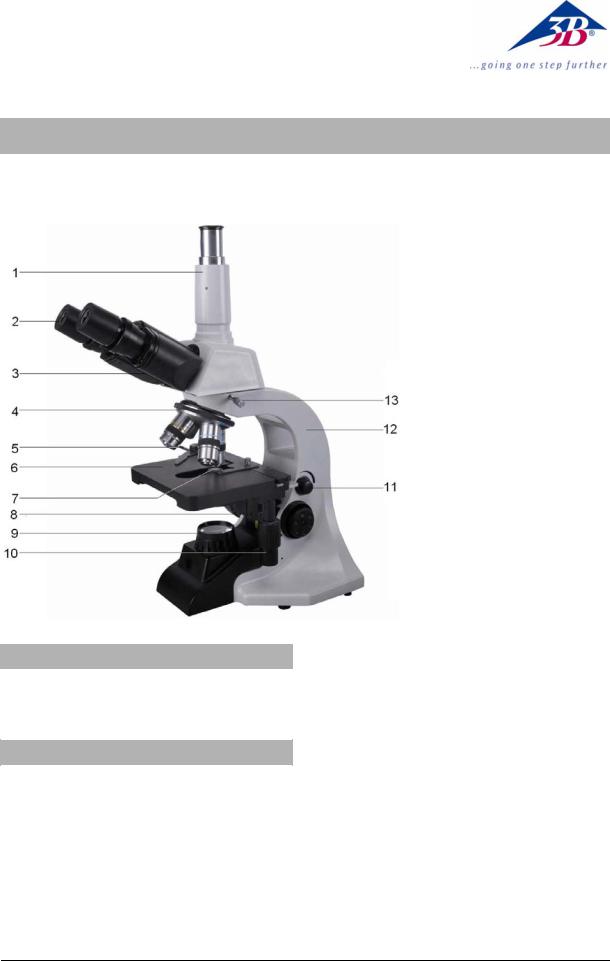3B Scientific N110 User Manual

3B SCIENTIFIC® PHYSICS
Trinocular Microscope Model N110 1013151
Instruction Manual
07/13 ALF
1.Safety notes
•For power supply use only electrical sockets with ground contact.
2.Description, technical data
The microscope model N110 allows twodimensional viewing of objects (thin sections of plant or animal specimen) in 40x to 1000x magnification and a eyepiece camera (e.g. 1003259, 1013379 and 1013380) to be attached for documenting work in the form of photographs and videos.
Stand: Robust, all metal stand with arm permanently connected to the base. Focussing by means of separate knobs for coarse and fine adjustment located on either side of the stand
1Vertical tube
2Eyepiece
3Binocular ube
4Revolver with objectives
5Object guide
6Object stage
7Condensor with iris diaphragm and filter holder
8Coarse and fine movement controls with holding brake
9Lamp housing
10Coaxial movement control for the object stage
11Illumination control
12Stand
13Head lock screw
Tube: Trinocular Siedentopf head, 360° rotatable, binocular tubus with 30° viewing angle, viewing distance adjustable between 55 and 75 mm, ±5 dioptric compensation, one tube with vertical viewing angle to attach a camera
Eyepiece: Pair of wide field eyepieces WF 10x 18 mm
Objectives: Revolving nosepiece with 4 achromatic objectives 4x / 0.10, 10x / 0.25, 40x / 0.65, 100x / 1.25 (oil)
Magnification: 40x, 100x, 400x, 1000x
Object stage: x-y cross table, 132 x 145 mm2, with object guide and coaxial adjustment knobs perpendicular to the object stage, adjustment range 78 x 54 mm2
Illumination: Adjustable LED lighting integrated in base, universal 100 to 240 V, 50/60 Hz power supply
1

Condenser: Abbe condenser N.A.1.25 NA 0.65 with iris diaphragm, filter holder and blue filter
Dimensions: 291 x 214 x 415 mm³ approx. Weight: 8 kg approx.
3. Unpacking and assembly
The microscope is packed in a molded styrofoam container.
•Take the container out of the carton remove the tape and carefully lift the top half off the container. Be careful not to let the optical items (objectives and eyepieces) drop down.
•To avoid condensation on the optical components, leave the microscope in the original packing to allow it to adjust to room temperature.
•Using both hands (one around the pillar and one around the base), lift the microscope from the container and put it on a stable desk.
•The objectives will be found within individual protective vials. Install the objectives into the microscope nosepiece from the lowest magnification to the highest, in a clockwise direction from the rear.
•Put the head onto the top of the stand and tighten the head-lock-screw. Insert the eyepieces into the tube.
4.Operation
4.1General information
•Set the microscope on a level table.
•Place the object to be observed in the centre of the specimen stage and clamp it to the object guide.
•Connect the mains cable to the net and turn on the switch to get the object illuminated.
•Make certain that the specimen is centered over the opening in the stage.
•Adjust the interpupillary distance so that one circle of light can be seen.
•Make the necessary eyepiece dioptre adjustments to suit your eyes.
•To obtain a high contrast, adjust the background illumination by means of the iris diaphragm and the variable illumination control.
•Rotate the nosepiece until the objective with the lowest magnification is pointed at the specimen. There is a definite “click” when each objective is lined up properly.
NOTE: It is best to begin with the lowest power objective. This is important to reveal general structural details with the largest field of view
first. Than you may increase the magnification as needed to reveal small details. When 100x (oil) objective is chosen, objective oil must be dripped onto the slide.
To determine the magnification at which you are viewing a specimen, multiply the power of the eyepiece by the power of the objective.
•Adjust the holding brake to give a suitable degree of tightness in the focusing mechanism.
•Adjust the coarse-focusing-knob which moves the stage up until the specimen is focused. Be careful that the objective does not make contact with the slide at any time. This may cause damage to the objective and/or crack your slide.
•Adjust the fine-focusing-knob to get the image more sharp and more clear.
•Colour filters may be inserted into the filter holder for definition of specimen parts. Swing the filter holder out and insert colour filters.
•Use the knobs of the mechanical stage to move the slide side-, backand forwards. The vernier provides accurate location of the specimen area.
•Always turn off the light immediately after use.
•Be careful not to spill any liquids on the microscope.
•Do not mishandle or impose unnecessary force on the microscope.
•Do not wipe the optics with your hands.
•Do not attempt to service the microscope yourself.
4.2 Changing the fuse
•Turn off the power switch and unplug the mains plug.
•Unscrew the fuse holder on the back of the stand base with a screwdriver.
•Replace the fuse and reinsert the holder in its socket.
5.Storage, cleaning and disposal
•Keep the microscope in a clean, dry and dust free place.
•When not in use always cover the microscope with the dust cover.
•Do not expose it to temperatures below 0°C and above 40°C and a max. relative humidity of over 85%.
•Always unplug the mains plug before cleaning or maintenance.
2
